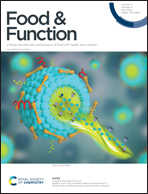The development of lentil derived protein–iron complexes and their effects on iron deficiency anemia in vitro†
Abstract
Iron deficiency anemia (IDA) is the most common nutrient-dependent health problem in the world and could be reversed by commercially available iron supplementation. The form of iron supplement is important due to its toxicity on the gastrointestinal system (GI), so the development of new dietary strategies might be important for the prevention of IDA. It has been shown that plant-based proteins bind to iron and might decrease the free form of iron before absorption and increase iron bioavailability. Thus, we aimed to form lentil derived protein–iron complexes and to test the functional properties of hydrolysed protein–iron complexes in anemic Caco-2 cell line. Our main findings were that (i) lentil derived proteins had the capacity to chelate iron minerals and (ii) hydrolysed protein–iron complexes significantly reduced the mRNA levels of iron regulated divalent metal transporter-1 (DMT1), transferrin receptor (TFR), and ankyrin repeat domain 37 (ANKRD37) marker genes that were induced by iron deficiency anemia. The current findings suggest that hydrolysed protein–iron complexes might have functional properties in iron deficiency anemia in vitro. Further in vivo studies are necessary to show lentil derived proteins and iron might be used as supplements or food additives to reduce the risk of iron deficiency anemia.


 Please wait while we load your content...
Please wait while we load your content...